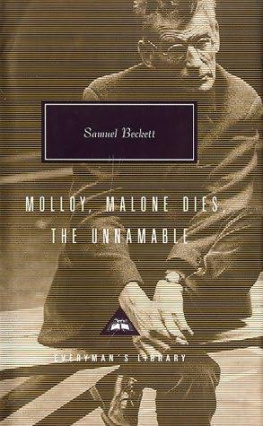Samuel Beckett - Malone Dies
Here you can read online Samuel Beckett - Malone Dies full text of the book (entire story) in english for free. Download pdf and epub, get meaning, cover and reviews about this ebook. year: 2009, publisher: Faber and Faber, genre: Art. Description of the work, (preface) as well as reviews are available. Best literature library LitArk.com created for fans of good reading and offers a wide selection of genres:
Romance novel
Science fiction
Adventure
Detective
Science
History
Home and family
Prose
Art
Politics
Computer
Non-fiction
Religion
Business
Children
Humor
Choose a favorite category and find really read worthwhile books. Enjoy immersion in the world of imagination, feel the emotions of the characters or learn something new for yourself, make an fascinating discovery.
- Book:Malone Dies
- Author:
- Publisher:Faber and Faber
- Genre:
- Year:2009
- Rating:5 / 5
- Favourites:Add to favourites
- Your mark:
- 100
- 1
- 2
- 3
- 4
- 5
Malone Dies: summary, description and annotation
We offer to read an annotation, description, summary or preface (depends on what the author of the book "Malone Dies" wrote himself). If you haven't found the necessary information about the book — write in the comments, we will try to find it.
Malone Dies — read online for free the complete book (whole text) full work
Below is the text of the book, divided by pages. System saving the place of the last page read, allows you to conveniently read the book "Malone Dies" online for free, without having to search again every time where you left off. Put a bookmark, and you can go to the page where you finished reading at any time.
Font size:
Interval:
Bookmark:

Samuel Beckett wrote the French-language novel Malone meurt between November 1947 and May 1948, at the height of a period of intense creative activity during which he also wrote the other novels of what has come to be known as the Trilogy Molloy and LInnomable as well as En attendant Godot, the play which first brought him international recognition. Beckett published his own translation of Malone meurt as Malone Dies with his American publisher, Grove Press, in 1956. This was subsequently published in the UK by John Calder in 1958, before appearing as the middle instalment of a trilogy in a Grove edition of the same year (with the subtitle Three Novels by Samuel Beckett), in an Olympia Press edition of 1959, and in a Calder edition also of 1959. Excerpts of Malone Dies appeared in periodical form in 1950 and 1956 (see Appendix), and a Penguin edition of the novel was published in 1962.
Malone Dies emerges from what Beckett called a frenzy of writing, stories tend to merge, becoming confused not only with one another but also with the story that Malone tells of his own existence , or what he calls his present state, as he lies dying.
The first of Malones stories tells of a boy named Saposcat, of his parents anxieties about his future, and of his strange relations with a local farming family called the Lamberts. This gives way to an account of a vagrant named Macmann, and finally to the story of Macmanns incarceration in an asylum named the House of Saint John of God. Malones story-telling produces a series of wonderfully vivid, compelling narrative fragments: Sapos blankly reflective evenings in the gloaming at the Lamberts farm; Mrs Lamberts fits of despair at the crass tenacity of life (p. 43) as she prepares the lentils for the familys dinner; Big Lamberts stoical burying of his loyal donkey; the doomed geriatric love affair between Macmann and his nurse, Moll; the Saint John of God inmates calamitous trip by boat to the island to see the Druid remains. These episodes or vignettes are written with extraordinary deftness and comic lightness of touch, involving the reader despite their lack of consequence . Malone sets narrative in motion and summons fictional scenarios as effortlessly as Picassos line drawings summon a camel or a horse.
But just as the air in Malones room seems to him lacking in oxygen, so the conditions required for narrative to thrive seem here to be lacking. No sooner does a story get going than it grinds to a halt. Malones characters freeze in mid-gesture, as he interrupts his story-telling to comment on the paucity of his fictions. Sapo loved nature, took an interest, Malone will declaim, in narrative mode, before breaking off to exclaim that this is awful (p. 15), that the stories provoke a mortal tedium (p. 44), that he cant do it (p. 21). One of the only plot lines to develop steadily across the novel is the erosion of Malones capacity to follow his own plot for the writing of his three stories. The fabric of his story-telling becomes increasingly threadbare, and his characters develop a more pronounced resemblance to himself, as narrative gives way to a fragmentary monologue in which even the fiction of Malones own presence in his room, writing stories in an exercise book with a dwindling pencil, starts to fail. The death of Malone, it might be inferred, is also the death of characterisation, the death of plot. But as narrative dwindles, it opens onto and explores the predicament of a voice that continues to speak, haltingly, even while having no story left to tell.
It is possible to read the trilogy as staging, in miniature, the trajectory that Becketts work would follow more generally, from the 1930s to the 1980s. Molloy begins with the premonition that his narrative will be the first of three stories, ending with the end of story-telling. This time, he writes, then once more I think, then perhaps a last time, then I think itll be over. It is easy to think of Malone as overseeing the second of these times: inheriting a shabby, malfunctioning narrative apparatus from Molloy, he disimproves it, before handing on to his apparent successor, the narrator of The Unnamable, a form of prose that survives only to witness the disappearance of its own conditions of possibility. With Malones demise, Malone predicts, it will be all over with the Murphys, Merciers, Molloys, Morans and Malones (p. 63), leaving the narrator of The Unnamable, if such a figure can be said to exist, to manage as best he can without character, plot, situation or any other of the trappings of the novel form. After the broken colours of Malones fragmentary stories, Becketts writing passes, via the agonised narrative wail of The Unnamable, to the fizzles and scraps of prose that make up his very short fictions of the 1960s and 1970s.
To read Malone Dies exclusively in terms of this trajectory, however, would be to make light of the singularity of Becketts novel. The question of the relation between the novel as a stand-alone piece, and as the central episode in a larger work, is indeed one that has shadowed its reception. Since the incorporation in the late 1950s of Malone Dies (by Grove, Calder and Olympia) as the second novel of a trilogy, the suggestion made by Malone himself that his narrative might be thought of as part of a larger work, and of a larger movement in Becketts oeuvre, has been
If this suggests that Beckett thought of his narrator as one of a series, however, he also felt strongly that Malone Dies was one of a kind. In correspondence with both his American and British publishers, Barney Rosset and John Calder respectively, Beckett was adamant that the self-sufficiency of Malone Dies be preserved. He wrote to Calder on 6 January 1958, in response to Calders request to describe the novels as a trilogy on the title page, Not Trilogy, I beseech you, just the three titles and nothing else, and to Barney Rosset in May 1969 that he couldnt bear the thought of trilogy.
This tension, in Becketts correspondence, between the novels independence and its interdependence can be found within Malone Dies itself, in the speakers ambivalence about his own identity. Malone thinks of himself in part as one of the Murphys, Merciers, Molloys, Morans and Malones for whom things will soon be all over, and throughout the novel he acknowledges his peculiar status as a kind of avatar, a form among other forms adopted temporarily by a narrating agency, rather than an autonomous subject. He describes feeling invaded by a larger narrative force for as long as I can remember the sensation is familiar of a blind and tired hand delving feebly in my particles (p. 51) as if animated by a puppeteer. One of Malones greatest desires is to give way to this occupying force, to yield his passing individuality to this narrative presence. Equally, Malones narrative is driven by a preoccupation with his own singularity, so that the desire to be another (p. 20), as he puts it, is balanced against an equal desire to be rid of the invasive agency which is responsible for Molloy who preceded him, and for the unnamable narrator who will follow.
One index of Malones struggle for singularity, and for independence from the series of which he is a part, is his relationship with his exercise-book, with the manuscript in which he composes his narrative and with which he has an unusually proprietorial relationship. He is happy to accept that the bed is not his, nor the dishes from which he eats, nor the pots into which he excretes, nor the cupboard in his room nor the blankets on his bed, nor even, when it comes to it, his own body, but he never accepts that the exercise-book is other than his. Nothing of all that is mine, he says; But the exercise-book is mine, I cant explain (p. 75). His notebook, and the words of which he is made, are more surely a mark of his singularity than any other of his formal properties, and in asserting this ownership he enters into a kind of struggle for editorial control with the narrative force that possesses him, the hand that he can feel plunged in me up to the elbow, and that clutches, ransacks, ravages, avenging its failure to scatter me with one sweep (p. 51). Malone dwells intently on the manual process by which he writes (My little finger glides before my pencil across the page, p. 33), the physical details of the notebook itself, the layout of words and in so doing he seeks to appropriate the manuscript, to wrest control from the author of that series which is so erosive of his own identity. The first pages, he writes, are covered with ciphers and other symbols and diagrams, with here and there a brief phrase. Calculations, I reckon. They seem to stop suddenly, prematurely at all events. As though discouraged. Perhaps it is astronomy, or astrology. I did not look closely. I drew a line, no, I did not even draw a line, and I wrote, Soon I shall be quite dead at last, and so on (p. 35). It is difficult to resist the thought that Malone is describing in part the notebook which contains the opening of Becketts draft of
Font size:
Interval:
Bookmark:
Similar books «Malone Dies»
Look at similar books to Malone Dies. We have selected literature similar in name and meaning in the hope of providing readers with more options to find new, interesting, not yet read works.
Discussion, reviews of the book Malone Dies and just readers' own opinions. Leave your comments, write what you think about the work, its meaning or the main characters. Specify what exactly you liked and what you didn't like, and why you think so.

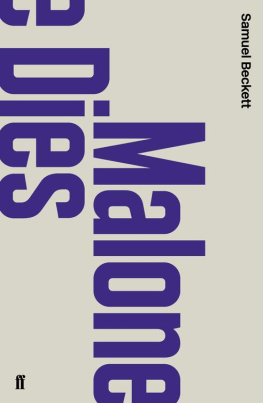
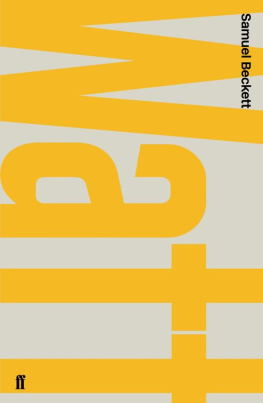
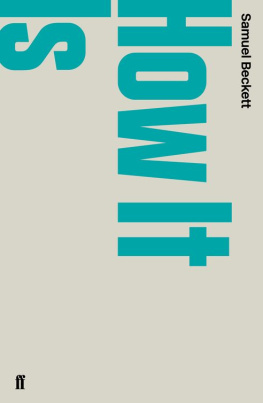
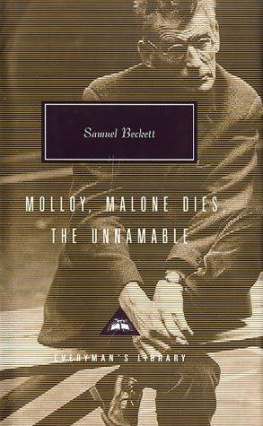
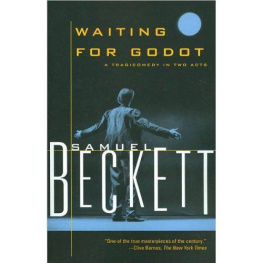
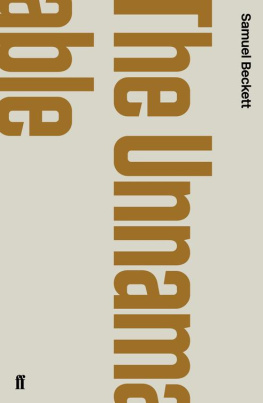
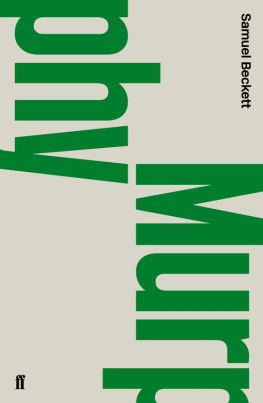
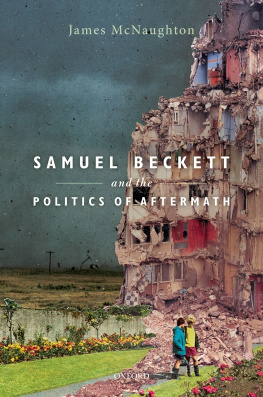
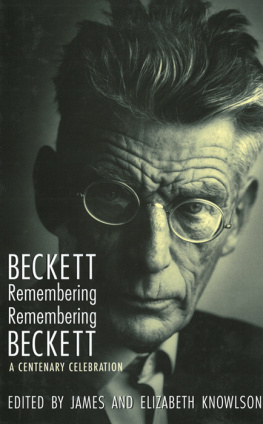
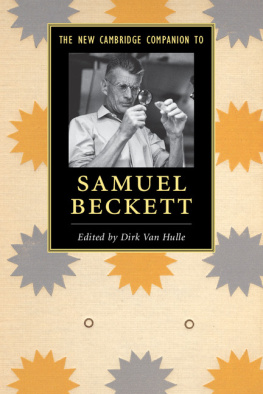


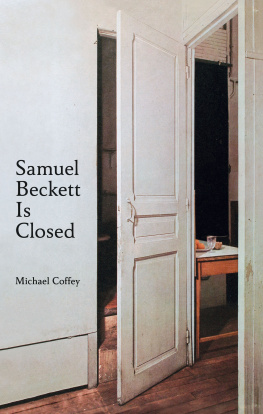
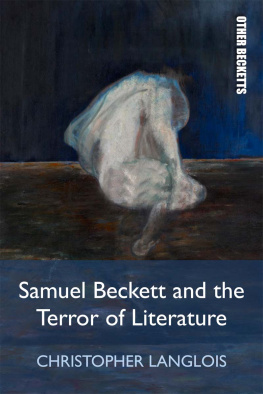
![Samuel Beckett [Samuel Beckett] - The Complete Dramatic Works](/uploads/posts/book/72751/thumbs/samuel-beckett-samuel-beckett-the-complete.jpg)
